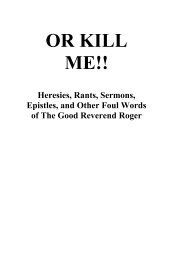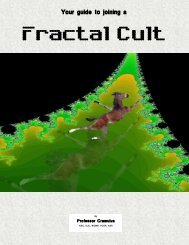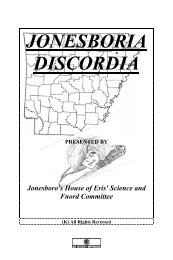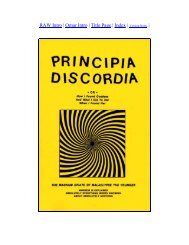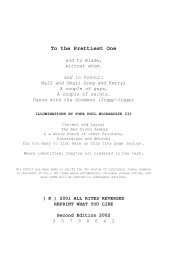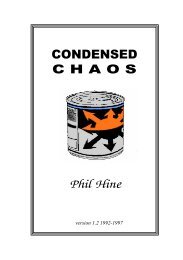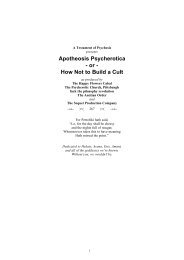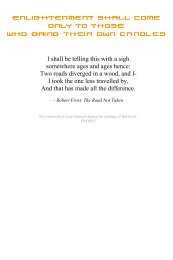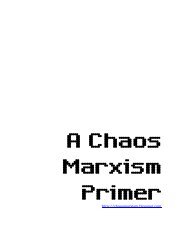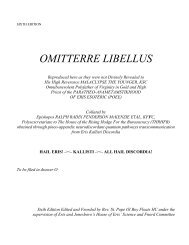Coincidance - Principia Discordia
Coincidance - Principia Discordia
Coincidance - Principia Discordia
Create successful ePaper yourself
Turn your PDF publications into a flip-book with our unique Google optimized e-Paper software.
152 COINCIDANCE<br />
disorder always increases in random processes. Here, randomizing produced<br />
more order instead of less.<br />
Hardy and Harvie could only suggest that probability and coincidence<br />
needed to be reexamined.<br />
Actually, this reexamination had begun as early as 1919 in a book called<br />
The Law of Series, by Dr. Paul Kammerer. As a biologist, Kammerer not only<br />
studied strange coincidences but developed a taxonomy of them. For<br />
instance, his brother-in-law went to a concert at which he had seat number 9<br />
and cloakroom ticket number 9. By itself, that would be a "series of the first<br />
order," in Kammerer's terminology. The next day, however, the brother-inlaw<br />
went to another concert and got seat 21 and cloakroom ticket 21. That<br />
makes a "series of the second order."<br />
Kammerer went on to list and give examples of series of the third order,<br />
fourth order, etc. He also provided a morphology involving powers (number<br />
of parallels in a coincidence) and a typology (coincidences of numbers,<br />
names, events).<br />
He concluded that coincidence represents an acausal principle in nature,<br />
as distinguished from the causal principles science had hitherto studied. He<br />
compared the acausal coincidental principle (ACOP, we shall call it for short)<br />
with gravity, noting that gravity acts on mass, while ACOP acts on form<br />
and function. He concluded, in words that foreshadowed some current<br />
speculations in quantum physics, "We thus arrive at the image of a worldmosaic<br />
. . . which, in spite of constant shufflings and rearrangements, also<br />
takes care of bringing like and like together."<br />
Jung eventually collaborated with Nobel physicist Wolfgang Pauli in<br />
developing a theory of coincidences that they called synchronkity. Pauli was<br />
attracted to the subject because he himself was haunted by malign<br />
coincidences that his fellow physicists jokingly called "the Pauli effect." As a<br />
theoretical, as distinguished from an experimental, physicist, Pauli did not<br />
spend much time in laboratories. It happened however that—more often<br />
than mere chance could explain—whenever Pauli was in a laboratory<br />
something got smashed or broken. It was not that he was clumsy; these<br />
accidents usually happened many yards away from him.<br />
TWO CONNECTIONS<br />
What Jung and Pauli suggested was that there are two kinds of<br />
connecting principles in nature. The first connecting principle is ordinary<br />
causality, which is what science usually studies. Causality is structured<br />
linearly in time: if A causes B, then A must occur in time before B. The other<br />
connecting principle is acausal, as Kammerer believed (though neither Jung<br />
nor Pauli appear to have read his book). The ACOP (acausal coincidental



